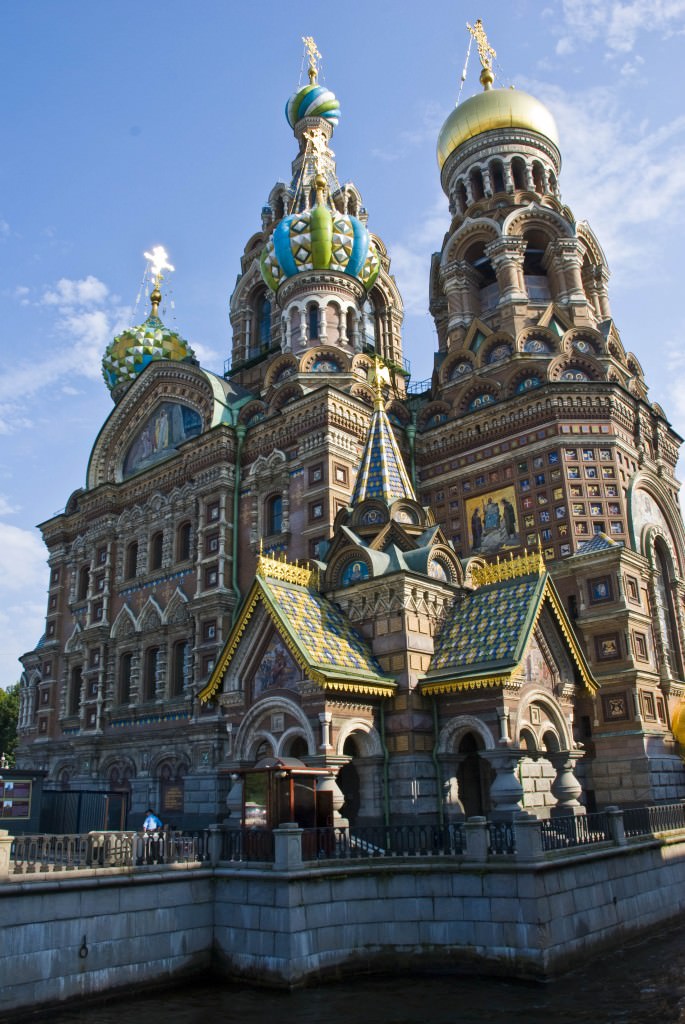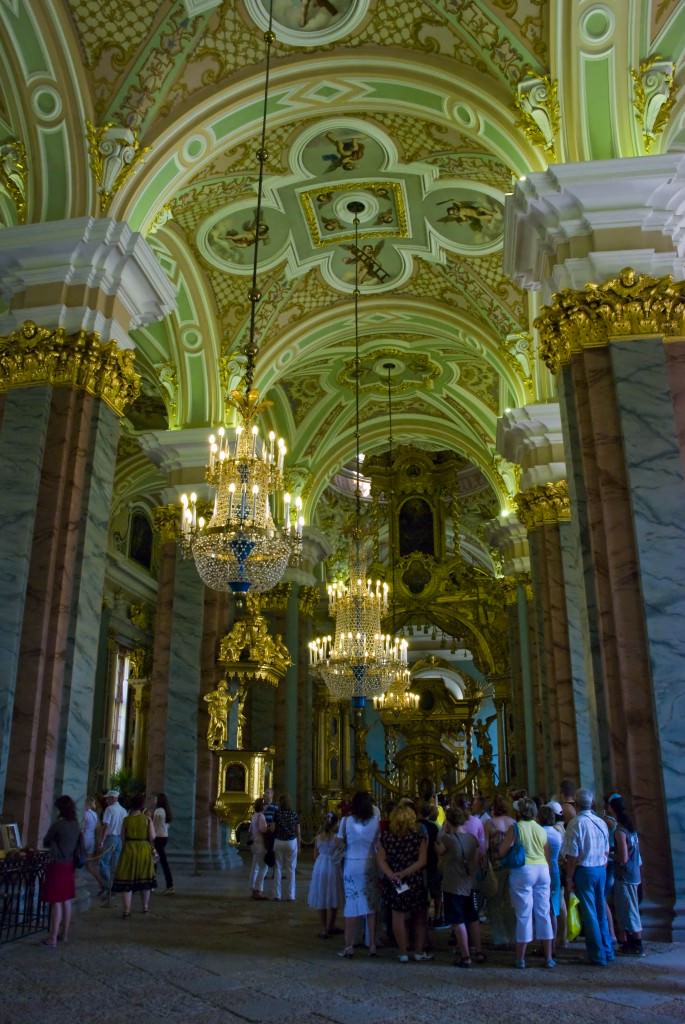St. Petersburg is like an old photograph: mysterious, alluring, strangely nostalgic. Its palaces, with their shuttered windows and paint peeling in pastel strips, invite fantasies of more elegant times. Flat-bottomed boats swoop through the canals, ducking past  the remnants of Russia’s imperial past. While it has transformed into a bustling, modern city, St. Petersburg retains its historical allure.
the remnants of Russia’s imperial past. While it has transformed into a bustling, modern city, St. Petersburg retains its historical allure.
Part of this allure comes from the influence of the Russian Orthodox Church. Everywhere you look, gold-tipped spires glitter against the rooftops. St. Petersburg is filled with cathedrals. From modest to extravagant, its houses of worship reflect the rich history of the Tsars’ former seat.
On Nevsky Prospekt, the city’s fashionable main street, shoppers stride between shops. But in the center of the Prospekt looms an uncharacteristic building: Kazan Cathedral. Built to resemble St.  Peter’s in the Vatican, it has an archaic, Roman aspect. Despite this Catholic association, it remains one of the most important churches of the Russian Orthodox faith. The colonnade sweeps out in a semi-circle, embracing a wide swath of human activity: fruit-sellers pushing carts of their wares; amorous teenagers; tourists thumbing guidebooks on benches; street musicians warbling their broken-sounding songs. History buffs may enjoy learning that General Kutuzov, who defended Russia against Napoleon and was immortalized in Tolstoy’s War and Peace, is buried here.
Peter’s in the Vatican, it has an archaic, Roman aspect. Despite this Catholic association, it remains one of the most important churches of the Russian Orthodox faith. The colonnade sweeps out in a semi-circle, embracing a wide swath of human activity: fruit-sellers pushing carts of their wares; amorous teenagers; tourists thumbing guidebooks on benches; street musicians warbling their broken-sounding songs. History buffs may enjoy learning that General Kutuzov, who defended Russia against Napoleon and was immortalized in Tolstoy’s War and Peace, is buried here.
 The immense golden dome of St. Isaac’s Cathedral dominates the Admiralty district. Now a museum, the cathedral’s upper decks warrant a visit. Visitors can pay to climb a dizzying winding staircase, and then a suspended wire catwalk. From the walkway around the dome, St. Petersburg reveals herself: canals snaking between stately Neo-Classical buildings; spires of distant churches; the Neva River sluicing down the center.
The immense golden dome of St. Isaac’s Cathedral dominates the Admiralty district. Now a museum, the cathedral’s upper decks warrant a visit. Visitors can pay to climb a dizzying winding staircase, and then a suspended wire catwalk. From the walkway around the dome, St. Petersburg reveals herself: canals snaking between stately Neo-Classical buildings; spires of distant churches; the Neva River sluicing down the center.
Across the river, on Zayachy Island, sits the Fortress of Peter and Paul. The defensive citadel, established by Tsar Peter the Great, is now a historical museum. After poking around the prison and print shop, most visitors find themselves at the Cathedral of Peter and Paul. With its sharpened gold needle, it looks slightly alarming. But inside, the Cathedral softens into a Baroque splash of colors: pink marble, pale green paint, molding covered in white and gold, and carved cherubim.
 In a grim reminder of Russia’s imperial history, the tombs of its royalty from Peter I onwards lie interred in the cathedral. Every Tsar except one has a tomb here – even Nicholas II, who was killed by the Bolsheviks. In the adjoining hallway – past the gift shop stuffed with babushka dolls and magnets– a photography display gives the story of the last Tsars and the efforts to inter Nicholas II and his family with their royal kin.
In a grim reminder of Russia’s imperial history, the tombs of its royalty from Peter I onwards lie interred in the cathedral. Every Tsar except one has a tomb here – even Nicholas II, who was killed by the Bolsheviks. In the adjoining hallway – past the gift shop stuffed with babushka dolls and magnets– a photography display gives the story of the last Tsars and the efforts to inter Nicholas II and his family with their royal kin.
The Church of Our Savior on the Spilled Blood stands out like a mirage from Nevsky Prospekt. Colors glop like ice cream cones; geometric designs stud the exterior. Every inch of its multi-domed, multi-colored façade gleams with design. The Russian Revival church, which sits picturesquely on a canal just off Nevsky, got its name from the murder of Tsar Alexander II, who was killed in this spot. Officially, it is still called the Church of the Resurrection of Christ. Mosaics cover most of the interior, complementing the church’s ornate style.
Gawkers stare at the candy-land church; the white northern sun bounces off the façade and scatters its colors into the canal. This is the iconic image of imperial Russia: grand, elegant, and almost mystical.
Written by Caitlin Dwyer for EuropeUpClose.com

Border-Less Travel
Tuesday 1st of February 2011
This is amazing. I don't think the world knows about this enough.